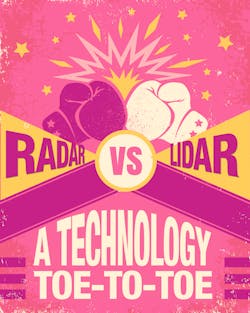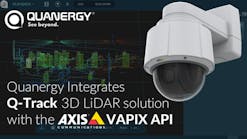Radar vs. LiDAR: A Technology Toe-to-Toe
While both are finding massive demand in the self-driving automotive industry, the advances being made in radar and LiDAR technologies are having a discernable effect on the perimeter surveillance industry, where both technologies are gaining momentum as viable alternatives or enhancements for detection along vast perimeters.
To learn more about these two technologies and their applications, SD&I caught up with security industry technology guru Steve Surfaro and Magos Systems America General Manager Yaron Zussman to weigh the benefits of each in this exclusive “technology toe-to-toe.” Which one is right for your client’s application is – of course – up to you to decide.
Technology Defined
Radar stands for “Radio Detection and Ranging” – utilizing radio frequency waves to detect targets. At its core, radar is an object detection sensor using radio waves to determine the range, altitude, direction and speed of objects. “This means radar can detect anything from an aircraft approaching an airport terminal to a human approaching a power plant fence line,” Zussman says. “Ground-based radar solutions provide 24/7, 360-degree coverage of any protected site, allowing for cost-effective, volumetric perimeter protection in all weather and lighting conditions.”
LiDAR (light imaging, detection, and ranging) uses pulsed laser light to measure distances in a similar way. “LiDAR bounces out laser beams, measures how long it takes for the light to hit an object or surface, calculating the distance to the object the light just hit and forming data points,” Surfaro says. “Millions of those data points, called “point clouds” are processed as a 3D visualization in seconds, rendering accurate object displays – all without video surveillance cameras. Unlike radar or sound waves, LiDAR does not dissipate as it travels back to its scanner.”
In general, LiDAR costs more than an average ground-based radar system. Both technologies can be easily mounted onto existing structures, eliminating the need to dig trenches and run excess cabling. Radar can also be low-power consumption devices; and some can be solar-powered.
Long-Range Detection
As Zussman explains, a single ground-based radar can reach up to 100 degrees in azimuth and 30 degrees in elevation – such expansive azimuth and elevation capabilities enable a single radar to cover an area with changing topography without the need for additional units. “Where 12 fixed surveillance cameras would be required for protecting an industrial facility, the same coverage could be achieved using a single radar unit,” Zussman says. “Weather and environmental conditions such as rain, snow or fog – which commonly plague video surveillance systems – do not affect radar.”
Another defining characteristic of radar technology is its long-range detection capabilities allowing early detection and alerting. When radar is deployed around the perimeter of a facility, approaching suspects will be automatically detected far away from the perimeter and security personnel will be alerted long before they reach the fence line. “Commercial radar is beginning to penetrate the security market, providing great detection for targets more than half a mile away,” Zussman says.
Because RADAR's radio waves have less absorption compared to the LiDAR's light waves when contacting objects, they can work over a longer distance and are often used in airplanes and battleships to detect potential threats hidden by weather conditions such as fog, rain, and snow and dust. In fact, Zusmman says the greatest differentiator between LiDAR and radar can be seen in field deployments with adverse weather conditions.
“LiDAR can be easily affected by fog, rain, or even dust,” Zussman says. “Light waves have short wave lengths, less than one-millionth of a meter to be exact, meaning they are easily absorbed by water droplets in the air. On the other hand, radio waves reach up to around five centimeters in wavelength, meaning that water droplets in fog, rain, snow, or even sand allow them to simply pass through.”
In cases where water droplets may be an issue, Surfaro says LiDAR should be used with secondary sensors such as cameras and ultrasonic sensors.
Integrated vs. Standalone
To create an effective perimeter intrusion detection solution, radar is usually integrated with a video surveillance system. “A key benefit of radar is that it seamlessly integrates with other security and sensory technologies to create a total perimeter solution that reduces response time,” Zussman says. “By integrating radar with a video surveillance system, the radar can automatically cue pan-tilt-zoom cameras to the location of an intruder, giving security officers a visual verification of the threat and allowing security personnel to keep eyes on the suspect as the individual moves. The VMS can then overlay the tracks of the trespasser onto a map of the property, providing even greater situational awareness. Linking it all together, security personnel can watch and track threats in real-time with the ability to intervene immediately.”
Surfaro agrees and adds that using radar to guide PTZ camera systems can significantly lower security costs by decreasing the number of cameras needed to monitor a site. “This method also covers a large area and in many cases eliminates video analytic software licensing costs,” he says.
A system of LiDAR sensors, on the other hand, does not need surveillance cameras to recognize objects, the direction they are facing and their trajectory. “Because radar renders a point or less recognizable ‘blob’ and the direction it is moving, the video surveillance camera(s) are required to confirm the type of object,” Surfaro says.
Accuracy and Definition
According to Surfaro, radar is less angularly accurate than LiDAR as it loses the sight of a target on curved pathways with a potential of confusion if multiple objects are placed very close to each other. “For example, radar may consider two small cars in the vicinity as one large vehicle and indicate an incorrect distance,” he says.
“Most LiDAR imagery has meaningful color gradients indicating the object’s elevation, and superlative detail in three dimensions, which is useful in recognition,” Surfaro adds. “In contrast, typical radar imagery is monochromatic rendering objects as “blobs” of similar shades.”
In the security industry, integrators and customers are often tasked with mitigating or detecting the threat of people breaching a perimeter to do harm. LiDAR not only detects people walking around an open area or intersection but it can also tell which direction they are facing. “LiDAR’s data rendering is highly detailed and accurate, enabling a security operator to accurately predict where a person will walk or a vehicle is driving, or how far into a perimeter a drone hovers,” Surfaro says. “This high level of (detail) allows the user to even see details like a person stealing high-value refined copper stock or holding a large automatic weapon.”
On a clear night, it is possible to see these details even two football fields away from a stationary or moving LiDAR device with very high accuracy, Surfaro adds.
Using this degree of accuracy, LiDAR has been used in recent smart city test initiatives in Las Vegas to help keep pedestrians, drivers and road workers safe. A pedestrian entering a crosswalk as traffic signals are changing, or a vehicle is stuck in an intersection results in traffic being automatically stopped in all directions. “Waymo's LiDAR system not only detects pedestrians but it can also tell which direction they are facing,” Surfaro says. “Thus, LiDAR enables perimeter protection systems to accurately predict where a thief may breach a protected space or where a pedestrian will walk.”
Enabling Artificial Intelligence
Both radar and LiDAR are helping to enable further use of Artificial Intelligence and deep learning in perimeter detection systems.
The detail and accuracy of LiDAR has enabled one company – Canada-based Geo-Plus – to create and integrate AI into its functionality. In fact, its VisionLidar point cloud software includes an object recognition tool to automatically detect and recognize the geometry of an object.
“Many solution providers have been successfully using artificial intelligence to ‘learn’ virtually any object, making LiDAR devices, in many cases, faster, more accurate and less costly than present day video analytics with network cameras,” Surfaro says.
Surfaro adds that another significant feature is that objects can be visualized and recognized while maintaining privacy in public spaces – a key consideration for clients who must abide by new GDPR rules. “Considering the high costs to ‘redact’ or blur facial features and vehicle license plates in video clips – often taking eight hours to process a single minute of surveillance video – LiDAR’s costs lower even further.”
Radar is also being paired with advanced artificial intelligence and deep learning-enabled software to enable precise object classification and false alarm reduction. “Today’s advanced radar systems are built with onboard signal processing and analytics, giving them the ability to work with video surveillance systems to determine whether a moving object is a threat or simply an animal,” Zussman explains. “This recognition capability significantly reduces the risk of nuisance alerts.”
3D Mapping
What would you do with ten billion points of LiDAR geolocation data in three dimensions? Build a Digital Elevation Model (DEM) or a Digital Surface Model (DSM)! Unique to LiDAR, these 3D models are so popular that there are now public imaging libraries that may be available to users needing 3D plots of a facility’s surrounding areas.
“Many facility managers with sprawling campuses, as well as regional airport managers often find themselves in a position to compromise a security design in favor of developing a ‘minimum needs’ plan,” Surfaro says. “From construction sites to mapping flood disaster areas, a LiDAR sensor can be mounted on a security guard's vehicle and come along for the ride, delivering 3D imagery.”
LiDAR devices produce survey-grade data using systems mounted on aircraft, drones, vehicles, vessels, and even backpacks. Both building heights and depressions (grades) of a facility's perimeter are rendered in an illustration colorizing objects according to their height. Using these 3D maps gives integrators a much better idea of where surveillance cameras can – or should – be mounted. The 3D map can also be used to pinpoint alarms or location of staff in need of medical attention.
Target Markets
Finally, because both radar and LiDAR deliver similar results, the target markets for these technologies are virtually identical. Potential monitoring opportunities include:
- Airports
- Bridges
- Commercial Facilities
- Construction Sites
- City traffic intersections
- Dams
- Data Centers
- Government Facilities
- Logistics, Distribution Centers
- Nuclear Power Plants
- Residential Estates
- K-12 and Higher Education perimeters
- UAV Protection
- Utility Substations
Paul Rothman is Editor-in-Chief of Security Dealer & Integrator (SD&I) magazine. Access the current issue, full archives and apply for a free subscription at www.secdealer.com.



